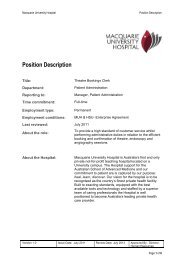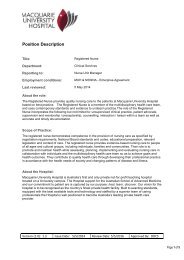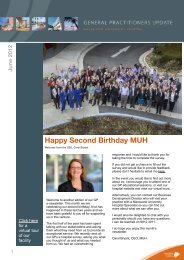Plenary Oral Presentations - Macquarie University Hospital
Plenary Oral Presentations - Macquarie University Hospital
Plenary Oral Presentations - Macquarie University Hospital
Create successful ePaper yourself
Turn your PDF publications into a flip-book with our unique Google optimized e-Paper software.
16 th International Meeting of the Leksell Gamma Knife ® SocietyMarch 2012, Sydney, AustraliaMA-34Delayed Radiation-Induced Vasculitic Encephalopathy:A Histopathological Correlation for Adverse RadiationImaging Effects after Radiosurgery1Veronica Chiang, 2 J.P.S Knisely, 3 A Vortmeyer1Yale School of Medicine, New Haven, CT2Yale School of Medicine, New Haven, CTObjective: Delayed diffuse leukoencephalopathy is a well-known complication of standard fractionatedexternal beam radiation therapy to the brain.Single fraction, high dose, focused radiation therapysuch as Gamma Knife radiosurgery is being increasingly used for the treatment of metastatic cancerto the brain to avoid such diffuse injury. However, adverse radiation effects (ARE) on MRimaging arenow also being reported in up to half of metastatic lesions treated with radiosurgery and are thoughtto also represent delayed leukoencephalopathy. While radiosurgery-induced leukoencephalopathy isknown to be clinically different than that following fractionated radiation, the pathological differencesare not well characterized. We retrospectively reviewed the radiographic and histopathological findingsin cases of surgically resected ARE to understand radiosurgery-induced leukoencephalopathy. Novelfindings are reported.Methods: We examined the histopathological tissue of 10 patients whose brain metastases had beenpreviously treated with Gamma Knife radiosurgery. In all of these patients, surgical management ofa symptomatic regrowing lesion was subsequently required. Given the surgical accessibility of theselesions, all were removed en bloc at Yale New Haven <strong>Hospital</strong> between January 1, 2009 and June 30,2010. All specimens showed no evidence of tumor recurrence upon thorough review of their histopathology.The clinical and magnetic resonance imaging data for each of the 10 patients were then reviewed.Results: The patients in this study all presented with progressively growing contrast-enhancing lesionson follow-up magnetic resonance imaging 8 to 17 months after Gamma Knife treatment, whichprompted surgical resection of the affected area. Neuropathologic examination revealed absenceof residual or recurrent tumor, but marked leukencephalopathic changes, including demyelination,coagulation necrosis and vascular sclerosis. In addition, abundant inflammatory cells were notedthroughout the parenchyma, which were mostly CD3+ T lymphocytes. Unexpectedly, small andmedium-sized vessels also showed a marked transmural T cell infiltrate indicative of active vasculitis.Conclusions: In this study involving 10 patients who received Gamma Knife stereotactic radiosurgicaltreatment for brain metastases, we provide evidence that radiation-induced leukoencephalopathy maypresent as a rapidly advancing process that grows to extend beyond the original high-dose radiationfield. We hypothesize that a vasculitic process in association with radiation leukoencephalopathy mayfacilitate the progressive nature of the condition.30
















